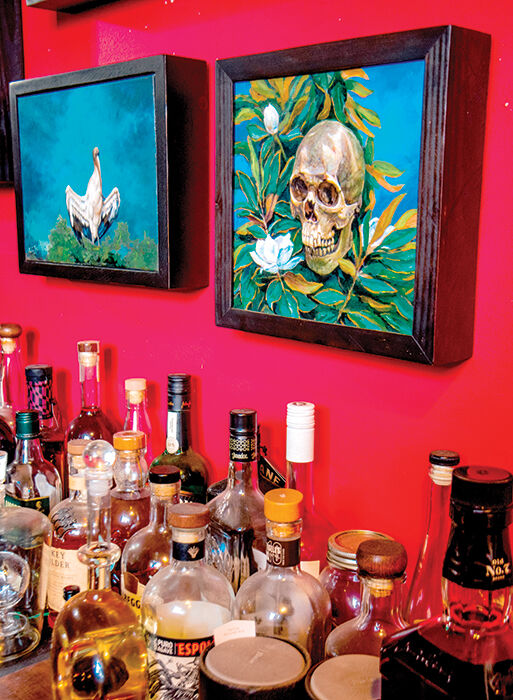Realism and Metaphor
Published 3:00 am Tuesday, February 7, 2023

- Tones of South Louisiana are evident in even his more recent works hung in the artist’s studio.
From glamorous balls to bead-flinging parades, Mardi Gras has been documented for centuries by writers and artists. But few painters have captured the merriment, mischief and colorful costuming the way Lafayette-based artist Herb Roe has in his series of oil paintings. For over a decade, Roe has created stunning scenes of one of the oldest traditions of the Cajun Mardi Gras, the Courir de Mardi Gras. His paintings are as rich as the Cajun history and culture of his adopted home in Acadiana.
Born in Portsmouth, OH, Roe grew up in nearby Greenup County, Kentucky – the Appalacians. He had early aspirations of being an artist, sketching at age 12 and inspired by the works of Dutch and Italian Baroque artists Caravaggio and Rubens who painted ordinary people in everyday scenes. “I took every art and drawing class that I could at school,” he recalls.
Years later while home on summer break from college, he met the Louisiana mural artist Robert Dafford who was painting the first of what turned out to be 100 murals on the flood wall in Portsmouth, depicting the city’s history. He took a job as Dafford’s assistant, and by the end of the summer dropped out of college to follow the muralist on to the next project in Harahan, LA.
He continued to work with Dafford for 15 years painting murals in the Ohio and Mississippi River Valleys, and in that time moving to Lafayette in 2000, while continuing to travel. “I felt a kinship to the people in Acadiana when I first moved to Lafayette. I saw a similarity to the culture of the people I grew up with in the Appalachians,” he shares.
In 2007 Roe went on his own to pursue a career as a fine artist. With a fondness for the theatrics of the Baroque style, he spent a couple of years painting large Renaissance- and Baroque-inspired costume dramas. “Then I started going to boucheries and Mardi Gras with a lot of my friends who are musicians,” he recounts. “I was 19 when I went to my first Courir de Mardi Gras. It was different but also reminded me of my home where families get together, oventimes butchering a hog. And the weird costume drama wasn’t too far off from the paintings that I was already doing.” The Courir de Mardi Gras provided the perfect theatrical backdrop for his paintings. His years spent working on murals made Roe accomplished at capturing an energy and a series of moments about a place, he says.
He describes his work as “realistic figurative painting” – not to be confused with photorealism. “My stuff is technically rendered and realistic,” he clarifies. He works in a variety of visual arts media, including large-scale historical murals, renderings, drawings and paintings, using both loose and tight techniques.
His process for determining the subjects, composition and mood of his Mardi Gras revelers take him to the countryside of Savoy, LA for the Courir de Mardi Gras, where it’s as authentic as it gets. “I want to accurately display the tradition,” he notes. Throughout the long day of mayhem, he snaps up to 700 pictures. Back at the studio, he hunts through them looking for good lighting, color and expressions. Only a handful will be used. He positions his selections to tell his allegorical tale, and working from his computer Photoshops them seamlessly together, making sure the light matches up, to produce one composite that will be his guide. He begins with detailed underdrawings, then gradually adds light, color, and two to 15 layers of paint and glazing for drama.
His scenes depict a wildness and a break from the civilized world, yet a sense of community and closeness. There’s a folklore feel, a theatrical quality with a cast of characters that includes riders galloping (or standing) on horseback, musicians, dancers, chicken chasers – and an occasional jester.
His background settings of the countryside feature live oaks draped in Spanish moss and misty scenes that invoke another-worldliness, symbolic of an ancient past– reminiscent of George Rodrigue. What makes Roe’s paintings so unique is that he masterfully expresses a joie de vivre while he represents the contemporary version of a very old tradition, Courier de Mardi Gras. People are drinking beer, mud wrestling and wearing sneakers in a beautiful Baroque style.
After 10 years of painting Mardi Gras, Roe pivoted to old world traditions like festivals, food, music and costumes that have survived through the centuries, portrayed in “Mythologies Louisianaises.” For the past four years, he’s turned his focus to the people and community around him, as well as the history of own Appalachian roots through a series titled “Pan-Southern.” Most recently, in a desire to detach from the literal traditional images and play with symbolism and metaphor, he’s branched off into a “Southern Gothic” style. “I want to provoke thoughts in the viewers’ minds and talk to them,” he explains. With skulls and skeletons shrouded in Mardi Gras beads in “Memento Mori,” he pushes his audience to create a story in their heads.
Working from his cozy Lafayette studio in the Artist Warehouse, Roe paints six to 18 hours a day. There are many all-nighters. “I often like to sit at night by myself and work on small details, and I’ll get involved in that until 3:30 in the morning,” he says, pouring the last of the coffee from a carafe.
This Mardi Gras marks Roe’s “ninth or tenth” courir in Savoy – he doesn’t keep count. When asked what he plans to wear, he casually points and nods to a large plastic tub off to the side, a trove of Mardi Gras costumes and masks from the past. “I think I might wear my Rougarou costume,” he answers. “It’s one of my favorites, with fake fur, a big tail and a werewolf mask.”
Fun Mardi Gras Facts:
• Mardi Gras is always held 47 days before Easter.
• The first Mardi Gras celebration in the U.S. took place in 1703 in Mobile, AL.
• Lafayette’s first recorded Mardi Gras celebration was Feb. 13, 1869.
• Participants in a Courir de Mardi Gras must wear a full mask at all times.
• One of the biggest events of a courir is when a guinea or Cornish hen is placed in a wire cage and hoisted atop a tall flagpole coated with cooking oil. Participants have to try and get the bird down.
• Bead tossing is said to have started in the late 19th century when a carnival king threw fake gems and jewelry to onlookers.
• New Orleans Mardi Gras parades have been canceled only 13 times, most recently due to COVID in 2021.





